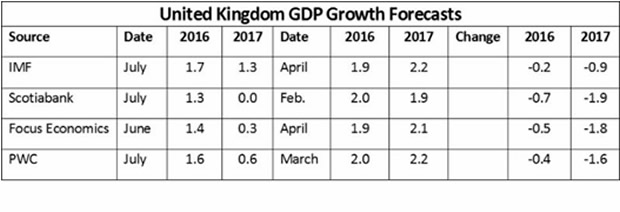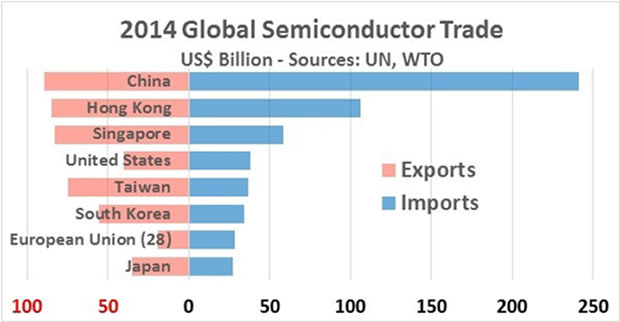How will Brexit impact semiconductors?
On 23rd June the voters of the United Kingdom (UK) chose to leave the European Union (EU) by a margin of 51.9 to 48.1%. The withdrawal of the UK from the EU is known as Brexit (for Britain Exit). The immediate impact of the vote was a drop in global stock markets, with UK markets the hardest hit. UK prime minister David Cameron, a supporter of the UK staying in the EU, resigned. He was replaced by Theresa May, who also opposed Brexit but has vowed to carry out the will of the people.
The longer term impact of Brexit is uncertain. The UK will likely negotiate a trade agreement with the EU which includes free trade between the two entities but not the free movement of people. Scotland may vote to leave the UK in order to join the EU. A 2014 referendum in Scotland was close, with 45% voting to leave the UK. There is a possibility other EU member nations may vote to leave. Italy, France, Sweden, the Netherlands, Austria, Finland and Hungary are mentioned as potential candidates. However, opinion polls show a majority of people in each of these countries favors staying in the EU.
The International Monetary Fund (IMF) has lowered their outlook for World economic growth in 2016 and 2017 primarily due to Brexit. The July 2016 IMF forecast calls for World GDP growth of 3.1% in 2016 and 3.4% in 2017, each down 0.1 percentage points from the April 2016 IMF forecast. The most significant change is the UK forecast with 2016 GDP growth down 0.2 percentage points and 2017 down 0.9 percentage points compared to the April forecast. Other forecasters are more pessimistic. Scotiabank expects zero UK GDP growth in 2017. The table below compares recent forecasts for UK GDP growth with forecasts made prior to the Brexit vote.
 The bigger question is whether Brexit is a sign of changing attitudes toward free trade. Trade has been a major issue in the United States presidential campaign. Republican nominee Donald Trump wants to renegotiate the North America Free Trade Agreement (NAFTA) among the U.S., Canada and Mexico. Trump is opposed to a U.S. trade agreement with Central America (CAFTA) and opposed to the Trans-Pacific Partnership (TPP) agreement among the U.S., Japan, Mexico, Canada, Chile, Peru, Australia, New Zealand, Singapore, Brunei, Vietnam and Malaysia. Trump wants aggressive trade negotiations with China, threatening punitive tariffs on U.S. imports from China. Expected Democratic nominee Hillary Clinton is also opposed to CAFTA and TPP, even though these are supported by President Barack Obama. Clinton has also questioned the effect of NAFTA, even though it was championed by her husband Bill Clinton when he was President.
The bigger question is whether Brexit is a sign of changing attitudes toward free trade. Trade has been a major issue in the United States presidential campaign. Republican nominee Donald Trump wants to renegotiate the North America Free Trade Agreement (NAFTA) among the U.S., Canada and Mexico. Trump is opposed to a U.S. trade agreement with Central America (CAFTA) and opposed to the Trans-Pacific Partnership (TPP) agreement among the U.S., Japan, Mexico, Canada, Chile, Peru, Australia, New Zealand, Singapore, Brunei, Vietnam and Malaysia. Trump wants aggressive trade negotiations with China, threatening punitive tariffs on U.S. imports from China. Expected Democratic nominee Hillary Clinton is also opposed to CAFTA and TPP, even though these are supported by President Barack Obama. Clinton has also questioned the effect of NAFTA, even though it was championed by her husband Bill Clinton when he was President.
How does all of this affect the semiconductor market? The direct effect of Brexit is not significant. The UK is not a meaningful producer or user of semiconductors. According to data collected by the United Nations (UN) UK imports of semiconductors were $2.4bn in 2014 and exports were $4.7bn, a small amount compared to the global market of $336 billion. An indirect effect is Japan's SoftBank Group has agreed UK's ARM Holdings PLC for $32bn. ARM designs and licenses processors which are in 95% of the world's smartphones, according the Wall Street Journal. SoftBank said Brexit did not affect the ARM bid, but it did make it cheaper as the Japanese yen has appreciated against the British pound since the Brexit vote.
If Brexit is a sign of moves toward more restrictive global trade, the impact on the semiconductor market could be substantial. Global trade has been important to semiconductors for decades. Semiconductor companies were among the first US companies to move some manufacturing overseas. One of the pioneer companies, Fairchild Semiconductor opened assembly sites in Hong Kong in 1961, South Korea in 1966 and Singapore in 1968. Fairchild was soon followed by Motorola opening a plant in South Korea and Texas Instruments opening plants in Taiwan and Singapore. Today wafer fab capacity is spread around the world. IC Insights shows capacity distribution at the end of 2015 as:
Taiwan 22%
South Korea 21%
Japan 17%
North America 14%
China 10%
Europe 6%
Rest of World 10%
The importance of global trade to the semiconductor market is evident by imports and exports by country. UN data for 2014 semiconductor imports and exports by key countries are shown in the chart below. The data for Taiwan is from the World Trade Organization (WTO) since it is not a UN member. Import and export data can be misleading as some countries such as Hong Kong and Singapore are trading hubs, with most of the semiconductor imports later included as semiconductor exports.

China is by far the largest importer of semiconductors at $241bn in 2014 (blue bars on right). Hong Kong and Singapore are the next largest sources of imports, but most of these are later exported. The US, Taiwan, South Korean, European Union (EU) and Japan are all significant importers, ranging from $27bn to $38bn. The major semiconductor exporters (red bars on left) correspond with the major wafer fab locations - China, US, Taiwan, South Korea, Japan and Europe (excluding the trading hubs of Hong Kong and Singapore). The total of the countries shown is $570bn in imports and $482bn in exports. The world semiconductor market was $336bn in 2014 according to WSTS. Thus many semiconductors pass through multiple countries on their journey from the country of manufacture to the country of final consumption.
The US Semiconductor Industry Association (SIA) supports the Trans-Pacific Partnership Agreement (TPP). The SIA states "International trade is vital to the U.S. semiconductor industry and the American economy as a whole." The TPP would simplify trade among the member nations while including provisions to protect intellectual property.
Trade agreements are controversial. Opponents in high wage countries fear the movement of jobs to lower wage countries. Proponents argue increased trade between nations increases overall economic activity and adds jobs. Global trade has been an important driver of the semiconductor industry. Hopefully Brexit is not a sign of future trade barriers which may hamper the growth of the industry.










